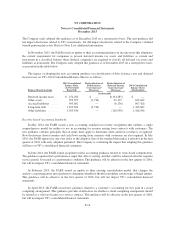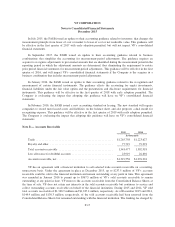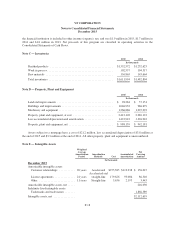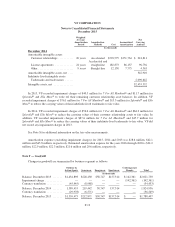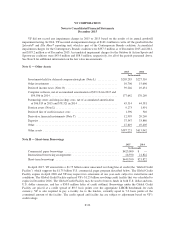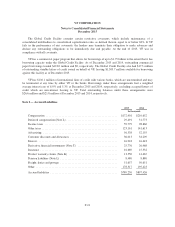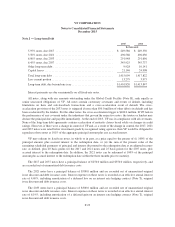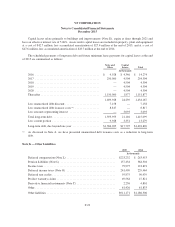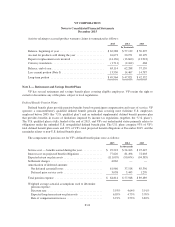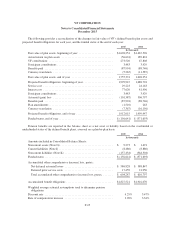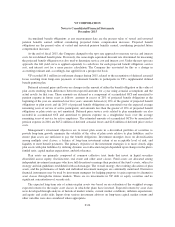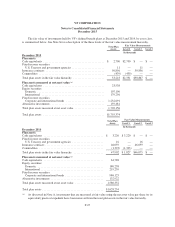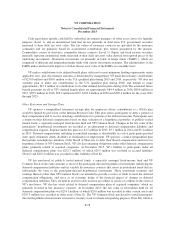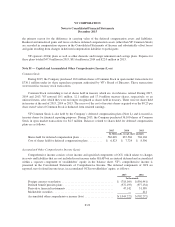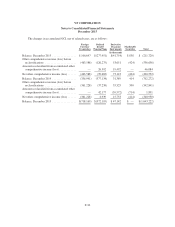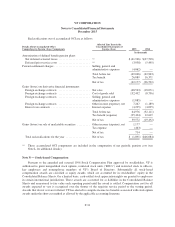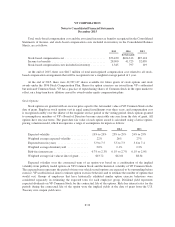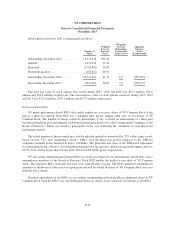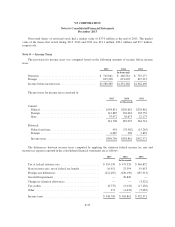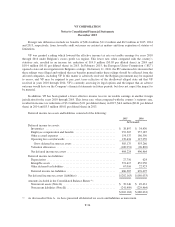North Face 2015 Annual Report Download - page 102
Download and view the complete annual report
Please find page 102 of the 2015 North Face annual report below. You can navigate through the pages in the report by either clicking on the pages listed below, or by using the keyword search tool below to find specific information within the annual report.VF CORPORATION
Notes to Consolidated Financial Statements
December 2015
Accumulated benefit obligations at any measurement date are the present value of vested and unvested
pension benefits earned, without considering projected future compensation increases. Projected benefit
obligations are the present value of vested and unvested pension benefits earned, considering projected future
compensation increases.
At the end of fiscal 2015, the Company changed to the spot rate approach to measure service and interest
costs for our defined benefit plans. Previously, the same single equivalent discount rate determined for measuring
the projected benefit obligation was also used to determine service cost and interest cost. Under the new spot rate
approach, the full yield curve is applied separately to cash flows for each projected benefit obligation, service
cost, and interest cost for a more precise calculation. The Company has accounted for this as a change in
accounting estimate and, accordingly, has applied it on a prospective basis.
VF recorded $4.1 million in settlement charges during 2015, related to the recognition of deferred actuarial
losses resulting from lump-sum payments of retirement benefits to participants in VF’s supplemental defined
benefit pension plan.
Deferred actuarial gains and losses are changes in the amount of either the benefit obligation or the value of
plan assets resulting from differences between expected amounts for a year using actuarial assumptions and the
actual results for that year. These amounts are deferred as a component of accumulated OCI and amortized to
pension expense in future years as follows: amounts in excess of 20% of projected benefit obligations at the
beginning of the year are amortized over five years; amounts between (i) 10% of the greater of projected benefit
obligations or plan assets and (ii) 20% of projected benefit obligations are amortized over the expected average
remaining years of service of active participants; and amounts less than the greater of 10% of projected benefit
obligations or plan assets are not amortized. Deferred prior service costs related to plan amendments are also
recorded in accumulated OCI and amortized to pension expense on a straight-line basis over the average
remaining years of service for active employees. The estimated amounts of accumulated OCI to be amortized to
pension expense in 2016 are $65.2 million of deferred actuarial losses and $2.6 million of deferred prior service
costs.
Management’s investment objectives are to invest plan assets in a diversified portfolio of securities to
provide long-term growth, minimize the volatility of the value of plan assets relative to plan liabilities, and to
ensure plan assets are sufficient to pay the benefit obligations. Investment strategies focus on diversification
among multiple asset classes, a balance of long-term investment return at an acceptable level of risk, and
liquidity to meet benefit payments. The primary objective of the investment strategies is to more closely align
plan assets with plan liabilities by utilizing dynamic asset allocation targets dependent upon changes in the plan’s
funded ratio, capital market expectations, and risk tolerance.
Plan assets are primarily composed of common collective trust funds that invest in liquid securities
diversified across equity, fixed-income, real estate and other asset classes. Fund assets are allocated among
independent investment managers who have full discretion to manage their portion of the fund’s assets, subject to
strategy and risk guidelines established with each manager. The overall strategy, the resulting allocations of plan
assets, and the performance of funds and individual investment managers are continually monitored. Derivative
financial instruments may be used by investment managers for hedging purposes to gain exposure to alternative
asset classes through the futures markets. There are no investments in VF debt or equity securities and no
significant concentrations of security risk.
The expected long-term rate of return on plan assets was based on an evaluation of the weighted average
expected returns for the major asset classes in which the plans have invested. Expected returns by asset class
were developed through analysis of historical market returns, current market conditions, inflation expectations,
and equity and credit risks. Inputs from various investment advisors on long-term capital market returns and
other variables were also considered where appropriate.
F-26


